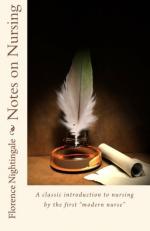The nervous frame really suffers as much from this as the digestive organs from long monotony of diet, as e.g. the soldier from his twenty-one years’ “boiled beef.”
[Sidenote: Colour and form means of recovery.]
The effect in sickness of beautiful objects, of variety of objects, and especially of brilliancy of colour is hardly at all appreciated.
Such cravings are usually called the “fancies” of patients. And often doubtless patients have “fancies,” as, e.g. when they desire two contradictions. But much more often, their (so called) “fancies” are the most valuable indications of what is necessary for their recovery. And it would be well if nurses would watch these (so called) “fancies” closely.
I have seen, in fevers (and felt, when I was a fever patient myself) the most acute suffering produced from the patient (in a hut) not being able to see out of window, and the knots in the wood being the only view. I shall never forget the rapture of fever patients over a bunch of bright-coloured flowers. I remember (in my own case) a nosegay of wild flowers being sent me, and from that moment recovery becoming more rapid.
[Sidenote: This is no fancy.]
People say the effect is only on the mind. It is no such thing. The effect is on the body, too. Little as we know about the way in which we are affected by form, by colour, and light, we do know this, that they have an actual physical effect.
Variety of form and brilliancy of colour in the objects presented to patients are actual means of recovery.
But it must be slow variety, e.g., if you shew a patient ten or twelve engravings successively, ten-to-one that he does not become cold and faint, or feverish, or even sick; but hang one up opposite him, one on each successive day, or week, or month, and he will revel in the variety.
[Sidenote: Flowers.]
The folly and ignorance which reign too often supreme over the sick-room, cannot be better exemplified than by this. While the nurse will leave the patient stewing in a corrupting atmosphere, the best ingredient of which is carbonic acid; she will deny him, on the plea of unhealthiness, a glass of cut-flowers, or a growing plant. Now, no one ever saw “overcrowding” by plants in a room or ward. And the carbonic acid they give off at nights would not poison a fly. Nay, in overcrowded rooms, they actually absorb carbonic acid and give off oxygen. Cut-flowers also decompose water and produce oxygen gas. It is true there are certain flowers, e.g., lilies, the smell of which is said to depress the nervous system. These are easily known by the smell, and can be avoided.
[Sidenote: Effect of body on mind.]




